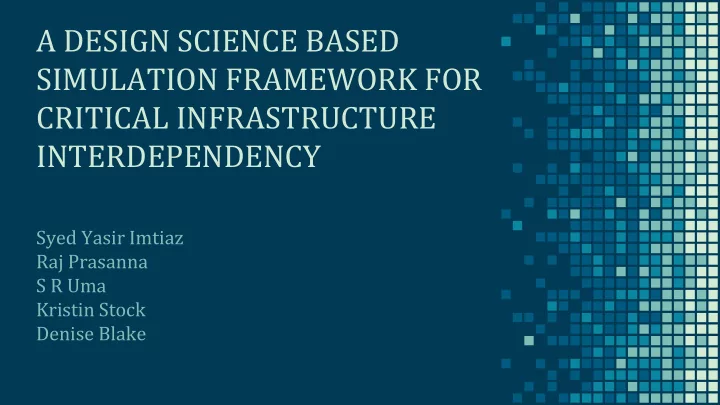

A DESIGN SCIENCE BASED SIMULATION FRAMEWORK FOR CRITICAL INFRASTRUCTURE INTERDEPENDENCY Syed Yasir Imtiaz Raj Prasanna S R Uma Kristin Stock Denise Blake
C RITICAL I NFRASTRUCTURES 2
3
DESIGN SCIENCE METHODOLOGY Environment Design Science Research Knowledge Base Application Domain Foundations Build Design - Technical Systems - Scientific Theories Artefacts and and Methods Processes - Organizational Systems - Expertise and Requirements Additions to KB Design Experience Relevance Cycle Rigor Cycle Cycle - People Field Testing Grounding - Problems and - Meta-Artifacts Oppertunities (Design Products Evaluate and Processes) 4
DESIGN SCIENCE METHODOLOGY 5
STRUCTURE OF AN ELECTRICITY NETWORK GXP 3 Transmission Structures GXP 2 Cables Substation Substation GXP 1 6 1 Substation Substation 5 2 Substation Substation 4 3 6
REPAIR ASSUMPTIONS ELECTRICITY NETWORK ASSUMPTIONS ▪ Various cable types may have different repair times for each damage. ▪ If the number of damaged cables exceeds a predefined value, then they would be replaced with emergency overhead lines. ▪ Priority would be given to the sensitive sites like hospitals, fire brigade offices, police stations and other emergency management centres. 7
REPAIR ASSUMPTIONS ROAD NETWORK ASSUMPTIONS ▪ Whole region is divided into different roadzones ▪ A matrix is developed that shows probable number of days needed to have road access between different zones ▪ Road access time is helpful during the calculation of various damaged components of electricity network 8
INTEGRATED METHODOLOGY Step 1 - Understanding the Damage map of roads, tunnels characteristics of infrastructure and bridges Road Model network Electricity GIS data of GXPs, Step 2 - Composition of fundamental Substations, Model Road access times Transmission between different zones structures and cables models for components Integration Module Step 3 - Dependency Identification Step 4 - Identification of common features Electricity Model Core Block Step 5 - Computation of Recovery time Step 6 – Development of Outage Maps Integrated Outputs (electricity network outage with road zone dependency) 9
ONGOING AND FUTURE WORK DEVELOPMENT OF A DECISION SUPPORT SYSTEM AROUND THE SIMULATION FRAMEWORK
DSS BASED ON DESIGN SCIENCE understanding of the real world where DSS will be applied Knowledge of basic components, processes and tasks carried out by the users Identify various classes of users that are expected to work with the DSS Analyse specific functions that the DSS is expected to provide. Design Cycle Development and Evaluation Cycle 11
CAPABILITIES OF THE DSS ▪ Can model electricity and road networks of any region (water network model in progress). ▪ Customizable repair strategies. ▪ Customizable network paths with option to add and delete any link between sources and destinations ▪ Batch processing of multiple damage models. Corresponding outage maps will be generated for each damage model. ▪ A comparison of different outage maps could be helpful to select the best recovery strategy. 12
EXAMPLE OF OUTAGE MAPS 13
THANKS! Any questions? You can find me at: y.syed@massey.ac.nz 14
Recommend
More recommend